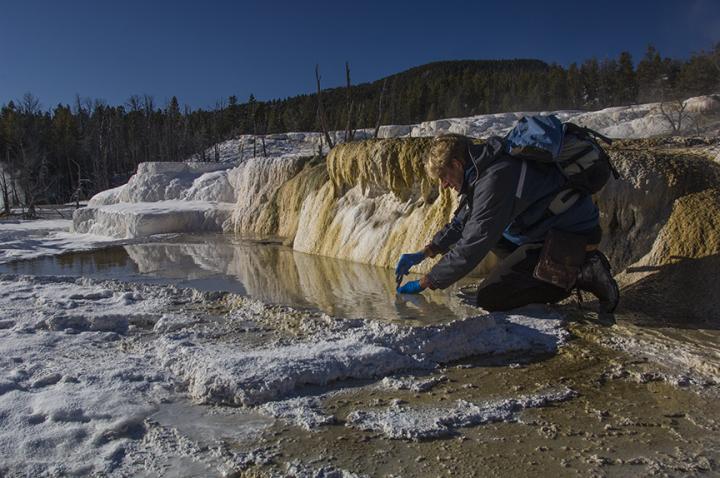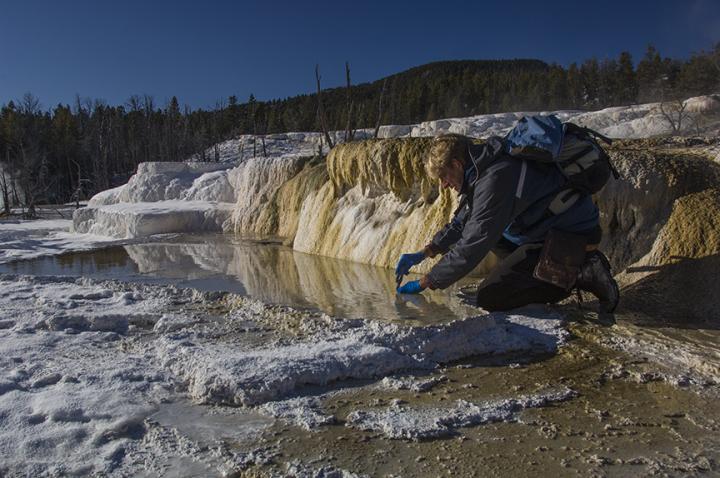
Credit: Tom Murphy
A new research project at the Carl R. Woese Institute for Genomic Biology (IGB) at the University of Illinois seeks to solve a $90 billion global problem in the oil industry while making oil drilling less harmful to the environment.
Bruce Fouke, Professor in the departments of Geology and Microbiology and director of the Roy J. Carver Biotechnology Center, was awarded a three-year grant from the Dow Chemical Company to study a process known as oil field biosouring. Fouke is also a faculty member in one of the IGB's eleven research themes, Biocomplexity, which explores the origin of life and the behavior of biological systems.
Co-investigators include IGB affiliate Professor Charles Werth at the University of Texas at Austin, and Robert Sanford, Research Associate Professor in Geology at Illinois.
Biosouring results from a common procedure in oil drilling, where seawater is pumped deep underground in order to maximize the amount of oil that can be extracted.
This action significantly affects microbes that live in the Earth's deep subsurface — known as the deep microbial biosphere — where the majority of Earth's life resides.
"The largest reservoir of living cells on earth is microbes that live underground," Fouke said. "Whenever we try to produce or extract oil and gas from the ground, we drill wells and perturb this community."
Seawater contains a chemical called sulfate. When bacteria in the ground ingest sulfate from the seawater, they create a byproduct called sulfide, which is highly corrosive and harmful to human health. This reduction, from sulfate to sulfide, is known as microbial biosouring.
Sulfide's corrosive nature creates the single largest maintenance expense for oil companies: replacement of underground oil field pipes and plumbing systems. Globally, it is estimated that almost $90 billion is spent on replacing damaged pipes each year.
"Dow is interested in the application of our techniques and approaches here at the IGB to better understand how biosouring happens and what new ways can be developed to reduce or stop it," Fouke said.
Another byproduct of biosouring is mineral growth. Biosouring accelerates the rate at which rocks are deposited, a process known as biomineralization, which is Fouke's area of expertise.
For the last 10 years, Fouke and his IGB research colleagues have been developing a new technology called the GeoBioCell, an experimental microfluidics test bed that can be used to track the interactions between water, rock, microbes, oil and gas in a controlled environment. It simulates the conditions of the deep subsurface on a microscope stage, using samples of actual oil field rocks and fluids.
This technology allows researchers to control the flow of these materials so their interactions can be evaluated in real time.
"We recreate, at a very precise spatial resolution, the interactions going on in natural subsurface environments," Fouke said.
By recreating biosouring within the GeoBioCell, researchers will be able to test different temperatures, chemicals, food sources and water chemistries to try and reduce or stop the process.
The IGB is the only place in the world where a technology like this exists, and Fouke said it's the only place where this research could happen, due to its interdisciplinary nature.
Directors of the IGB Core Facilities light microscopy suite and the Roy J. Carver Biotechnology Center will be collaborating in running and analyzing the GeoBioCell experiments.
"It's truly the only laboratory in the world where we have the capacity to do all these cutting-edge analyses in one location," Fouke said.
For Fouke, this research brings together years of his own work.
"What's especially exciting about this project, and the development and application of the GeoBioCell, is that it represents two decades of collaborative interdisciplinary research," he said. "It encapsulates everything we have accomplished to date."
As a geologist, Fouke's interest lies in studying the origin and evolution of life on Earth, and how this knowledge can be applied to solve real-world problems.
"Results from the GeoBioCell experimentation will enhance our understanding of how oil and gas is produced, while better protecting the environment," he said.
He believes the project's "hyper-interdisciplinary" nature — involving the fields of geology, microbiology and engineering — will allow the results to be impactful.
"It requires exactly what we're all about at the IGB, which is to have the highest level of excellence and expertise in these different fields, and then have them all come together and work together," Fouke said. "It takes all these disciplines fusing together to be able to complete this work."
###
Media Contact
Nicholas Vasi
[email protected]
@IGBIllinois
http://www.igb.uiuc.edu
Original Source
http://www.igb.illinois.edu/article/research-investigate-oil-field-biosouring-new-technology





